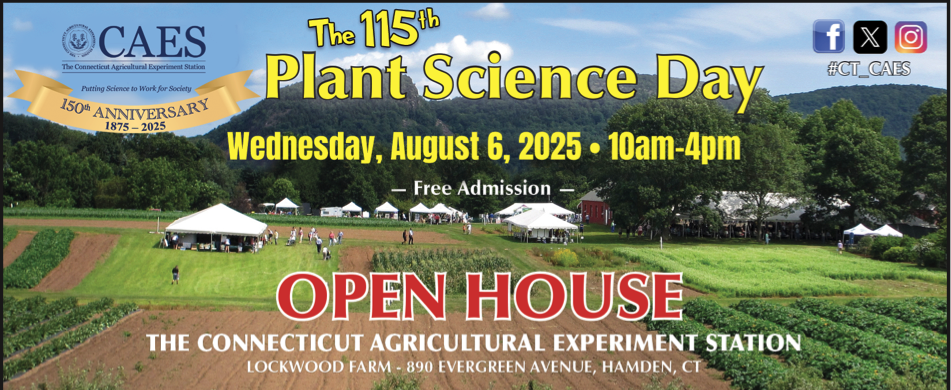What to be on the lookout for…
Basil Downy Mildew
This week basil downy mildew was confirmed in Hartford County. Leaf yellowing is often the first symptom of basil downy mildew. Yellowed areas are usually bordered by leaf veins. When spores are produced, a characteristic fuzzy, dark gray to purple growth on the underside of the leaves is evident. Sporulation on the upper surfaces of leaves may be seen in severe cases. Fungicides can provide good control of this disease with regular, timely applications, especially if the variety has some resistance to DM. Heritage, Reason, Revus, Ranman, and phosphorus acid fungicides are among the labeled fungicides.
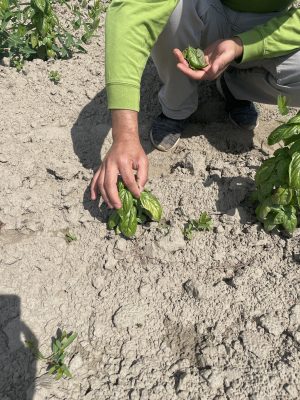
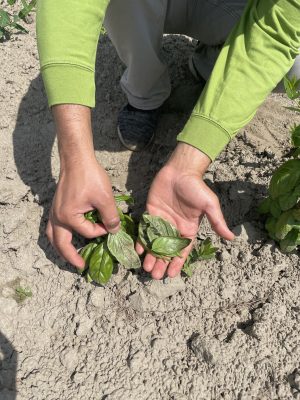
Resistant basil varieties have also been available for several years and have been providing an extra two or more weeks of basil harvest compared to standard varieties. Based on varietal responses in UMass trials, a recommended combination of varieties to grow is Prospera and Passion, and then introduce the new Prospera Active (which contains a 2nd BDM resistance gene in addition to the gene in the original Prospera) later in the season.
Cucumber downy mildew which infects cucumbers and cantaloupes is a different strain from basil downy mildew. The downy mildew that impacts pumpkins has not been seen in Connecticut yet this season.
Gray Mold/Botrytis Blight of Tomato
Gray mold, also known as botrytis blight, is a common disease of tomatoes and is particularly damaging in greenhouses or high tunnels where the relative humidity is high. The pathogen infects leaves, stems, petioles, and fruit. Ghost spots develop when the pathogen invades the fruit then ceases growth prior to causing decay; the resulting white to yellow rings make the fruit unmarketable.
To manage gray mold, keep humidity below 80% by ventilating, pruning, and spacing plants. Avoid wetting the foliage during times when drying is slow. Practice strict sanitation, removing senescent tissues and infected crop debris as it can become airborne and spread. Fungicides can be applied to protect against infection, they will not suppress what has already been infected. Fungicide rotations and combinations are important because resistance has been reported to several fungicides.
See the New England Vegetable Management Guide for spray options for tomatoes in greenhouses and high tunnels or field tomatoes.
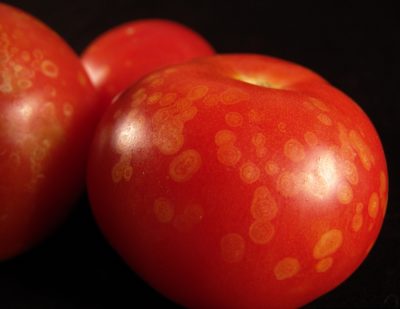
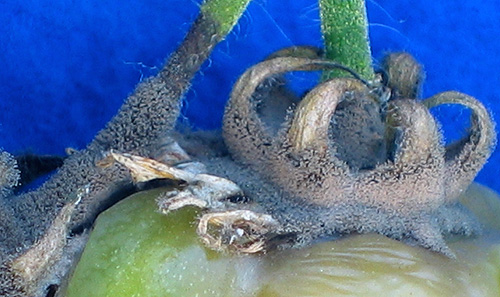
Tomato Leaf Mold
When relative humidity is greater than 85% and tomato plants are growing rapidly into denser plantings (so air circulation is reduced) leaf mold thrives. As a result, leaf mold (known by the scientific name Passalora fulva and previously known as Fulvia fulva or Cladosporium fulva) is commonly found in high tunnels. The fungus can cause leaves to yellow and reduce overall yield.
To control leaf mold, it is critical to improve airflow and reduce humidity by venting and pruning. Additional recommendations include:
- Removing infected foliage can slow the spread of disease from leaf to leaf and plant to plant.
- Avoid excessive nitrogen fertilization.
- Remove diseased leaves, place them in a plastic bag, and destroy.
- At the end of the crop cycle, remove and destroy all plant residue.
- For the following season, consider using resistant cultivars and certified disease-free seed.
Spray options for greenhouse and high tunnel tomatoes can be found using the New England Vegetable Management Guide.
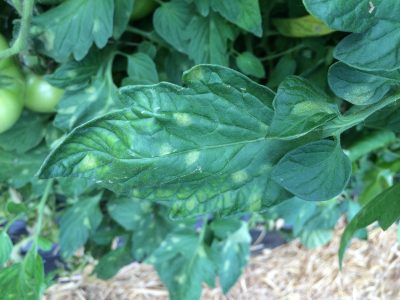
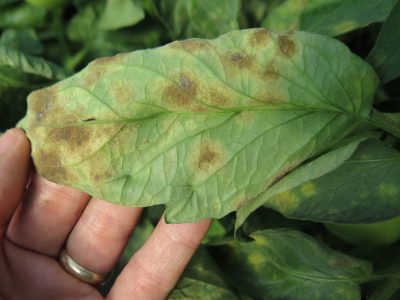
Mexican Bean Beetles
Be on the lookout for Mexican bean beetles (MBB). Adults and larvae feed primarily on leaves, but when numbers are high, they will also damage bean pods. Feeding damage over 10-20% can cause yield loss. Plants are most sensitive in the pod fill stage. Scout for MBB by searching plants for adults, eggs and larvae, and assessing damage. Prompt destruction of beans in the same or adjacent fields year after year.
Annual releases of the larval parasitoid Pediobius foveolatus, timed to coincide with egg hatch, can help control beetle larvae. Field experiments at Virginia Tech have shown that MBB are less likely to colonize and deposit eggs on beans on metalized and white plastic mulches, compared to bare ground and black plastic. Beans planted on metalized and white plastic mulches also had less foliar damage, less pod damage, and significantly greater yields than beans grown on black plastic and bare ground.
See the New England Vegetable Management Guide for spray options. Be sure to get coverage of the lower leaf surfaces when spraying.

Verticillium Wilt
Verticillium wilt is caused by two specials of a soil-borne fungi. It infects eggplants, peppers, cucurbits, and many other crops. A yellowing of lower leaves followed by wilting is the first sign of disease. Lesions have a characteristic V-shaped pattern which is widest at the leaf margin. Symptoms can appear on one side of the plant or on one side of a leaf (a more prevalent symptom in eggplant and tomatoes). When the stems of infected plants are cut lengthwise, the vascular tissue exhibits a brown discoloration.
Verticillium species can persist in the soil for many years in the absence of susceptible plants. Follow a 4-5 year crop rotation with non-solanaceous and non-cucurbit crops to reduce inoculum levels in fields. Include grain crops in the rotation. Control weeds as many weeds are susceptible to Verticillium. Remove and destroy infected plant material after harvest. There are no effective chemical controls. Some resistant or tolerant eggplant varieties exist.
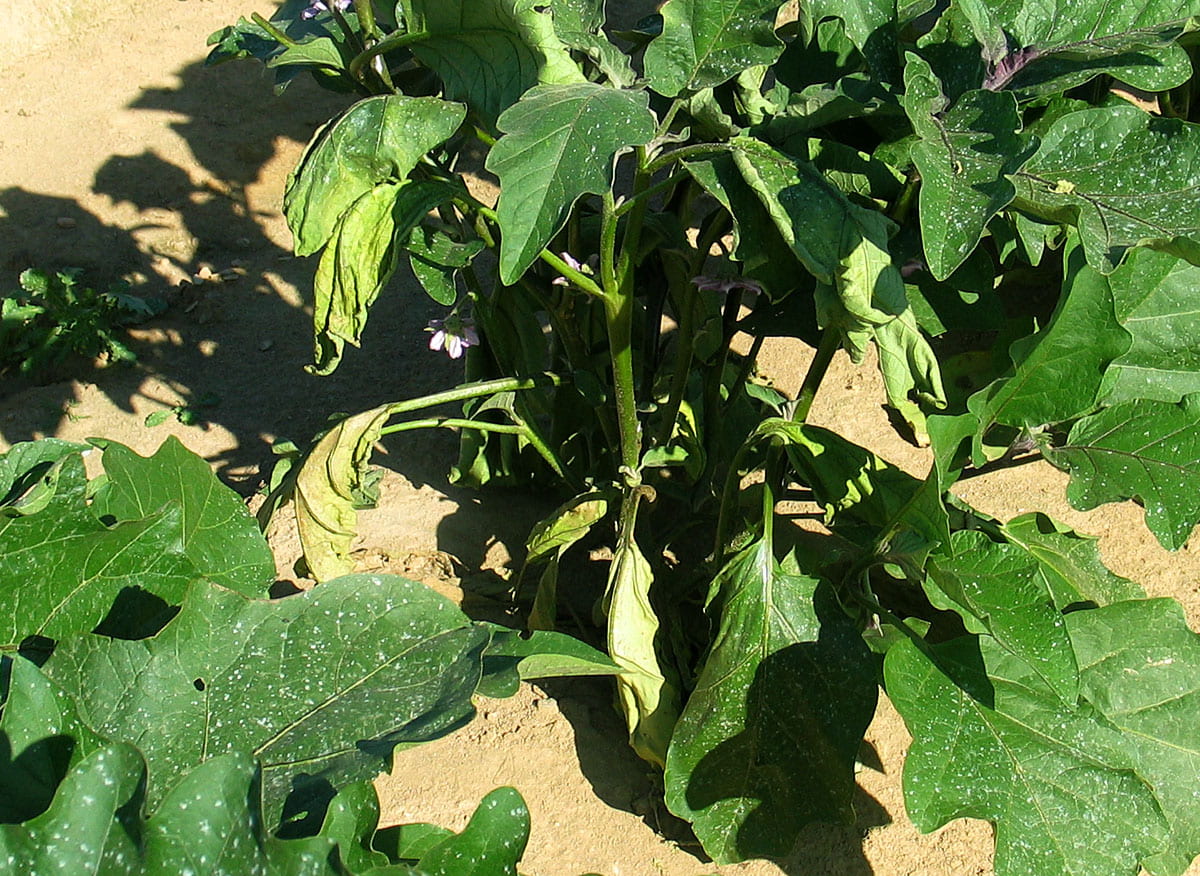
Sweet Corn Pests - Trap Count Update
| Location | CEW (avg per night) | ECB - NY | ECB - IA | ECB - III | FAW |
| Glastonbury A | 1 | 1 | 0 | 1 | 0 |
| Glastonbury B | 1.4 | 3 | 1 | 2 | 4 |
| Berlin | .6 | 1 | 0 | 0 | - |
| Shelton | 1 | 0 | 1 | 0 | 0 |
Note: We caught wainscot moths in FAW traps and spongy moths in ECB traps. Accurate ID of moths in traps is important. View our Sweet Corn Pest ID Guide.
Squash Vine Borer Trap Count (Berlin): 2
Spray intervals for CEW can be found on our website. See the New England Vegetable Management Guide for management strategies for all sweet corn insect pests.
Notice to CT Fertilizer and Soil Amendment Registrants from CT DoAG
The Connecticut Department of Agriculture recently sent a letter to all registrants concerning a legislative update regarding the use of PFAS. Details of that letter are included below:
Effective July 1, 2025: Section 21 of PA 25-152 (amending C.G.S. 22a-903c) PFAS Ban in Fertilizers is added to Existing Ban of PFAS in Soil Amendments
No person shall use, sell or offer for sale in this state any fertilizer intended for land application or soil amendment that contains any biosolids or wastewater sludge that contain PFAS.
If your fertilizer or soil amendment product contains biosolids, you must provide a certificate of compliance stating that the product does not contain PFAS. This proof of compliance must be furnished by the product’s manufacturer or supplier to the Connecticut Department of Agriculture at the time of product registration or renewal.
Any such certificate of compliance shall be signed by an authorized official of the manufacturer or supplier.
A certificate of compliance shall be kept on file by the manufacturer or supplier of the fertilizer or soil amendment.
In order to comply with this new law, send a certificate of compliance to AGR.Commodities@ct.gov for your fertilizer and soil amendment products that contain biosolids by August 31, 2025, OR remove your fertilizer and soil amendment products containing biosolids from Connecticut stores by August 31, 2025. Failure to do so will result in violation notices and stop sales.
Any further questions can be directed to AGR.Commodities@ct.gov.
Resource: Managing Flood Risks on Farms
Our team at UConn Extension has put together a factsheet to help you navigate flood risks on your farm. From preparing before a big storm to dealing with the aftermath, this short guide covers practical steps to help protect your crops, soil, and equipment. With more extreme weather events happening across the region, it's a good time to think about how to reduce damage and recover safely if flooding occurs.
Read the factsheet: Managing Flood Risks on Farms
Additional State Resources:
Continue to be on the lookout for...
Striped and Spotted Cucumber Beetles
Flea Beetles: Brassica and Solanaceous
Want the New England Vegetable Management Guide and/or Northeast Vegetable and Strawberry Pest ID Guide at your fingertips?
The Connecticut Agricultural Experiment Station’s Plant Science Day is held at Lockwood Farm on the first Wednesday of August every year, beginning in 1910. This one-day event features reports on research, opportunity for pesticide credits, field plots, barn exhibits, tours, and other opportunities for Connecticut residents and attendees to discuss many topics of plant science on an informal basis and interact with CAES scientists and staff.
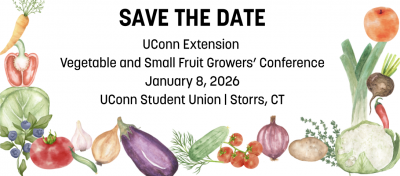
Stay in touch with us
- Share what you see: We're here to assist with identification, management strategies, and guidance on best practices. Send us a photo/message via text at 959-929-1031.
- Facebook Group: UConn Extension moderates a private Facebook group specifically for commercial vegetable producers. It is a space to share photos of insects and diseases you find in your fields, ask questions, share ideas, and stay engaged with growers across the state. Join the "UConn Extension - Vegetable IPM" Facebook Group
- Schedule a consultation: Would you benefit from meeting with an Extension Specialist at your farm to provide insight on pest or disease identification, management strategies, and more? If so, please contact our Vegetable Extension Specialist, Shuresh Ghimire, to setup a farm visit. Contact him at shuresh.ghimire@uconn.edu or 860-870-6933.
Contact Information
Shuresh Ghimire, Vegetable Extension Specialist: shuresh.ghimire@uconn.edu
Nicole Davidow, Vegetable Extension Outreach Assistant: nicole.davidow@uconn.edu
Vegetable IPM Office Phone Number:
860-870-6933
Vegetable IPM Cell Phone Number:
959-929-1031 (feel free to text/iMessage photos)
Vegetable IPM Pest Alert Audio Recording:
860-870-6954
Thank you for reading!
This report was prepared by Nicole Davidow, Outreach Assistant, and Shuresh Ghimire, Commercial Vegetable Specialist, UConn Extension.

The information in this document is for educational purposes only. Any reference to commercial products, trade or brand names is for information only, and no endorsement or approval is intended. Always read the label before using any pesticide. The label is the legal document for product use. Disregard any information in this report if it is in conflict with the label. UConn Extension does not guarantee or warrant the standard of any product referenced or imply approval of the product to the exclusion of others which also may be available. The University of Connecticut, UConn Extension, College of Agriculture, Health and Natural Resources is an equal opportunity program provider.

